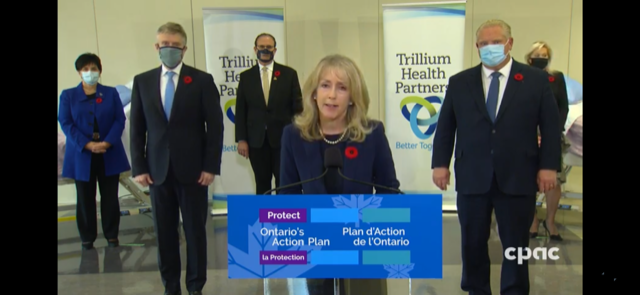As Ontario battles COVID-19, it’s clear that the virus has not let up its tight grip on long-term care homes.
2,341 of Ontario’s 3,836 deaths are in long-term care homes (61%).
In December alone, 98 deaths have occurred in homes.
Merrilee Fullerton, Ontario’s Minister of Long-Term Care, acknowledges the pain and loss that people have experienced.
“It’s a horrible, horrible pandemic. COVID-19 really is an insidious virus, and it spreads in very highly transmissible ways. It’s almost impossible to detect.”
Fullerton says that with long-term care homes now adapting to the rapid testing, as well as an increase in general testing, homes are picking up cases before they come into the facility.
“It’s mostly on people coming in from the community and that’s an important realization that’s happened since the first wave; asymptomatic spread. […] This has been a continuous learning process.”
Fullerton says that what we’re seeing in Ontario now is growing cases across the community, which makes it difficult to keep out of the long-term care homes.
“We have to have even more robust testing. That’s why we’re doing the rapid tests, and those are starting. The vaccine is coming I know people want to hear about that, and long-term care will be a priority area for that.”
The provincial government has invested hundreds of millions into the long-term care homes to address staffing, changes homes had to make at physical structures to prevent spread, as well as the infection prevention control measures.
“This is a virus we’re continuing to learn about – shoring up our homes is a priority for our government. Rebuilding, repairing and advancing long-term care has to be done,” said Fullerton.
Ontario currently has 115 long-term care homes in outbreak, but Fullerton says that 68 of those homes have no resident cases.
“They’re considered in outbreak because there may be staff that have been identified through our surveillance testing, and are self-isolating at home. There are 68 homes with no resident cases of the homes considered in outbreak. That’s an important point. it means our surveillance testing is working for the most part. But I want to emphasize, one case of COVID-19 getting into a home, and going undetected, is devastating in some cases,” she said.
Fullerton says that the question ‘Why is this still happening?’ is important, and she says it’s because they aren’t able to detect every single virus coming into the long term care homes.
“We’re really refining how we get our tests done all at the same time for a home, so we don’t get a few tests back. We want a complete picture. If we can get the regular PCR tests rapidly, and get them arriving in batches… so that we can understand at the same time who has it right now, how many cases are in that home, and really identify staff and residents as soon as possible that allows the home to cohort, separate, or send individuals to the hospital if they need to, or transfer residents to locations where they may be better served.”
Fullerton says it’s a cross-government, cross-agency effort.
“It’s a massive effort to stop the spread in the homes. [All a home needs is] one single case. That’s why it’s so important for everyone in the community to do what they can to stop the spread; Washing hands, wearing a mask, limiting social contacts especially during holidays. It’s easy to let our guard down, but all it takes is one case getting into that long-term care home and we have devastation.”





